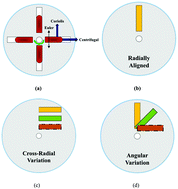Interplay of Coriolis effect with rheology results in unique blood dynamics on a compact disc†
Abstract
We investigate the influence of rotational forces on blood dynamics in a microfluidic device. The special confluence of Coriolis force and blood rheology is brought forth by analyzing the flow at different hematocrit (volume fraction of red blood cells) levels and rotational speeds. We further study the effects of channel layout and alignment with regard to the axis of rotation to understand this intricate interplay. We provide a sound basis for efficient designing of a lab on a compact disc (lab on CD) platform by harnessing the effects of Coriolis force at relatively much lower rotational speeds, in sharp contrast with the reported findings where Coriolis effects have been considered to be effective only for exceptionally high rotational speeds. Our results show that over certain intermediate regimes of rotational speeds, the flow profiles for different hematocrit levels are noticeably different. This, in turn, could be harnessed as a possible diagnostic signature of the hematocrit (or equivalently, packed cell volume) level, without necessitating the deployment of chemical consumables, in an energy efficient paradigm.



 Please wait while we load your content...
Please wait while we load your content...